Growing Eggplant
We planted twelve eggplant plants this year, sown indoors in mid-February. Since we have no experience growing eggplant, we chose eight different varieties in order to find the types that grow best in our soil. We chose the Asian trio from Renee's Garden (which consists of Asian Bride, Little Fingers and Farmer's Long), Italian trio from Renee's Garden (which consists of Rosa Bianca, Beatrice and Nadia), Hansel from Park's Seeds and Lavender Touch from Park's Seeds. I was surprised to learn that there are so many more types of eggplant than the big fat ones you find in the grocery store! The seeds germinated rather slowly, and the seedlings grew even slower, but we did have near 100% success rate with the seedlings. Once transplanted into the garden, the seedlings from Renee's Garden had a higher success rate than those from Park's Seeds. Several of the Park's Seeds seedlings damped off and had to be replaced.
This is how small the plants were when they were first set out into the garden. (The eggplant are in the center of the garden between the lettuce and soybeans.) This was three months after sowing the seeds. We placed paper cup collars over the plants to prevent cutworm injury. Eggplant should not be planted in the garden until night time temperatures remain above 50 degrees since they are very temperamental about cold temperatures, which stunt their growth.
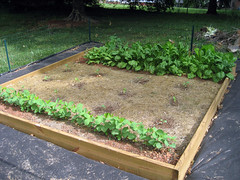
Here is their progress a month later. You can see holes in the leaves caused by the flea beetles.

And here is their present state, finally reaching the height of the soybeans.
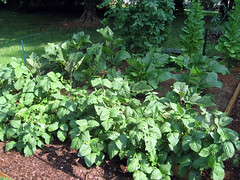
I was so excited to see the first eggplant flowers form, as I had no clue where eggplant fruit came from. I have never actually seen an eggplant plant until I planted them myself!
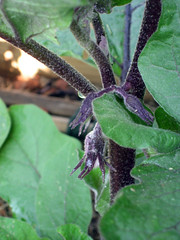
The thick velvety flowers open to a lovely shade of purple with bright yellow centers. Each of the plants is full of flowers right now. One plant has over twenty flowers on it!
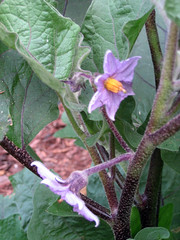
Bees work hard to pollinate the flowers, which eventually form fruit, in the same way tomatoes form their fruit.
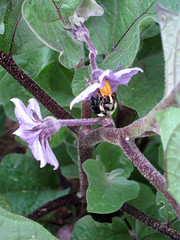
Here is our first eggplant fruit! I think it is going to be a Nadia. I was very bad about mixing up the seedlings and not mapping out their final location in the garden, so it will be a surprise when they all start to fruit!
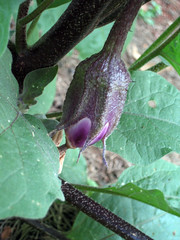
Not only are eggplant slow growers and fickle about cold temperatures, but they are very susceptible to flea beetle attacks. When the plants were very small, this was a serious problem, because a couple flea beetles could do a lot of damage to the pair of tender leaves. I did have to spray them with Sevin twice, since the organic spray solutions did not help. Once the plants grew larger and stronger, I stopped spraying. Now I just pick the beetles off the plants in the morning and afternoon. A few beetles won't do much damage to a large plant, so I just keep them under control manually. I hate spraying, but you have to be as persistent as the flea beetles if you are going to control them without spray. I have a lot of respect for organic eggplant farmers after this experience! I can't imagine how they do it.
We enjoy eggplant in numerous dishes; we put them in curry, grill them with olive oil, salt pepper, and roast them in the oven. I am looking forward to trying some eggplant parmesan too! Although it is my favorite Italian dish, we have never tried to make it at home.
Labels: asheville, eggplant, gardening, vegetables

0 Comments:
Post a Comment
Subscribe to Post Comments [Atom]
<< Home